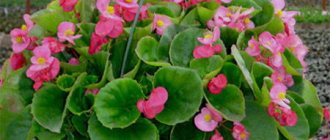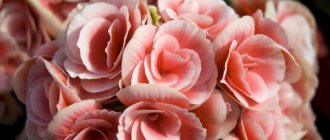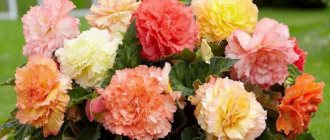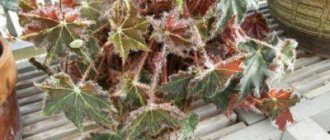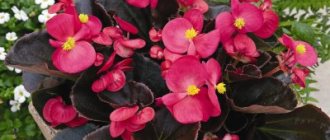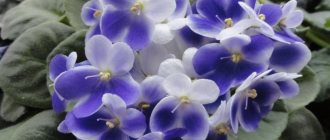Begonia is one of the most common and popular plants among gardeners. She is unpretentious and has a beautiful appearance; they strive to show her first of all. Houseplants that are well known to us belong to the genus of the same name, which includes shrubs and subshrubs, vines and herbaceous plants. There are also epiphytes - plants growing on other representatives of the flora.
Caring for decorative deciduous begonias at home
Landing
It is advisable to carry out all manipulations with the plant in early spring , when it is just beginning to grow. The fact is that planting and replanting slow down development for some time, because begonia experiences stress from changed conditions. It is important to take this into account when bringing a new plant from the store to your home or office. Store-bought begonia was grown in greenhouse conditions in compliance with all the rules, but at home it is forced to adapt in a new way.
Priming
The soil used is slightly acidic or closer to neutral . It should be loose and fertile. Leaf soil and humus are taken and pre-disinfected. Sand is added to this mixture. It is also recommended to add perlite or vermiculite to improve the quality of the soil.
Pot
The container for deciduous begonias is wide, but not deep. Plastic pots work well ; it is easy to remove the plant from them when the need for replanting arises. Holes must be made at the bottom of the pot - this provides additional air access to the roots and the outflow of excess water.
Watering
For irrigation, water is settled or boiled. Water only when the top layer of soil is dry. Experts also determine the need for watering by changes in the weight of the pot. You can gradually pour water from the pan until the top layer darkens.
In summer a frequent supply of moisture is required, in winter less often and always after the top layer of soil has dried to a depth of at least 1 cm.
Do not allow excess moisture; it is better to water begonia less.
Air humidity
Prefers moderate humidity. If the air is too dry, there is a high probability of spider mites appearing, and if the humidity is high, there is a risk of rotting roots and leaves. It is not recommended to spray begonia. To increase air humidity, containers with water are placed next to the pot or the begonia is placed on a wide tray into which moistened expanded clay is poured.
Temperature
Prefers moderate temperatures from 18 to 25 degrees. It is not advisable to place the plant next to cold drafts and radiators. In summer they are placed in a cool place.
Location
Begonia loves light, but it must be diffused. Bright sun will burn the leaves and make them pale or increase the amount of green pigment, reducing the variegation. Lack of lighting will affect growth and reduce the variegation of foliage.
Begonias do not like sudden changes in location, however, in order for the foliage to grow evenly, the plant can be slowly rotated relative to the light source.
General characteristics of the plant
In its family, Begoniaceae is the most common genus. Among them are:
- annual herbs;
- shrubs;
- perennial herbs;
- subshrubs.
Their rhizome is tuberous, thickened, with a tuber or creeping. The shape of the leaves is asymmetrical; they themselves have uneven edges, wavy or jagged. Can be divided into several parts. The color is uneven and variegated. Part of the leaf is purple, red or brown, and the rest is green. The drawing can be patterned, with many lines and a scattering of dots. In a number of species, the leaves are covered with villi. The flowers are small, large or medium. By large we mean a flower whose size reaches 20-30 cm in diameter. Shades range from red and yellow to snow-white. The edges of the flower petals are edged with a different color.
Reproduction
Most types of domestic begonias are easy to propagate. Take a small cutting about 5 cm long and place it in a glass of clean water. The best time for this is spring. Instead of cuttings, leaves are used, they are cut with a sharp knife, and the sections are disinfected with charcoal. Reproduction is also possible in parts of the leaf blade, cutting it so that the central vein remains on each piece. After this, the pieces are laid on loose soil, sand or perlite, pressed against them, and covered with a bag or jar on top.
After rooting, cuttings are planted in small pots or plastic cups. You cannot immediately plant it in a large container - the soil in such a pot takes a long time to dry out, which can lead to the death of a young specimen.
Transfer
Every spring, the soil is renewed and the plant is replanted. If it has grown greatly and the roots have become crowded, then take a pot a little wider than before. A layer of drainage is poured onto the bottom , for which expanded clay or brick chips are taken. The roots are cleared of old soil, the plant is placed in a new pot and carefully sprinkled with soil, sometimes tapping the pot so that the soil lies evenly. After this, the begonia must be watered, and excess water is removed from the pan.
Chocolate Cream
The most beautiful hybrid begonia, distinguished by large leaves and petioles twisted in the form of a spiral. The leaves have an unusually attractive color: the outer surface is bright plum color with pronounced dark brown veins, the middle part is silvery-light green, with a silvery-pink border along the edges. The edge is fringed with small serrations. It appears to glow with a silvery light.
Features of care in winter
In winter, most plants go into a dormant period. Watering is reduced.
The amount of light decreases in winter, so begonia is placed closer to the window or artificial lighting is added.
Protect the plant from exposure to cold air and radiators. Carefully monitor the watering regime, its excess will lead to rotting of the root system.
Also read on our website about the following varieties of begonia: Red-leaved, Bauer, Masona, Hogweed, Cleopatra, Royal, Spotted, Vorotnichkovaya.
Types of classifications
There are a huge number of varieties of begonias: in just over the 3rd century, 2 thousand species were described (the Botanic Garden of Scotland described the 2 thousandth new species, registered it in early March 2022). The plant easily forms hybrids in natural conditions. And also because of the highly decorative nature of the flower, it is often crossed by breeders.
Begonia elatior
At the moment there is no single generally accepted classification. For convenience, flower growers conditionally divide them into several groups.
Important! All plant varieties require the natural habitat conditions of begonias: high air humidity, diffused sunlight and a temperature of 13–22 ᵒC. But care for different types may differ slightly.
Conditional divisions are often encountered:
- by characteristics and method of application (decorative foliage and flowering);
- by location (garden and indoor);
- by type of root system (rhizomatous, tuberous or fibrous);
- by the presence and type of stem (bush or tuberous), etc.
In 2007, in a popular book on indoor plants, its author, Professor V.V. Vorontsov, proposed a conditional classification into 4 groups: shrubby, tuberous, decorative deciduous and flowering.
There is also a pan-European classification based on the method of reproduction and other biological characteristics. She divides the plant into the following groups: cane begonias, bush begonias, rhizomes, royal begonias, thick begonias, ever-blooming begonias, tuberous begonias and climbing begonias.
Diseases and pests
Too humid air and excess watering in winter will lead to the appearance of powdery mildew: plaque appears on the leaves and they die.
When the air is dry, the edges of the leaves dry out and turn brown. With a lack of lighting, the leaves stretch out, become small and pale.
In the summer, begonia may be attacked by aphids, which were accidentally brought in from the street. Spider mites are also likely to appear - they love dry air. To remove pests, use the drug Actellik, which is sprayed on the plant.
Begonia is an almost ideal plant to keep at home or in the office. It looks great in green corners and winter gardens.
Decorative leaf begonia purifies indoor air and helps fight dangerous bacteria.
Perle de Paris
The height of the plant does not exceed 30 cm. Begonia is a lush, well-branched, spreading bush with unusually attractive leaves of a silvery hue. The wavy plate is decorated with a pinkish border. There are dark, clearly visible veins on its surface.
Photo
Below you will see photos on how to care for decorative deciduous begonias at home:
What kind of begonia is it?
This plant is divided into three main types: herbaceous, shrubby and subshrub. Its leaves are the same for the entire plant genus: asymmetrical with a rugged blade. Begonia can be admired during the flowering period. After pollination, buds of different colors appear on it. Moreover, all flowers have an exceptionally bright color.
Begonia was first noticed in the late 17th century in Europe. Later, scientists discovered an evergreen type of plant, and even later - a royal and tuberous one.
A well-known fact: an asteroid was named after begonia in 1920.
